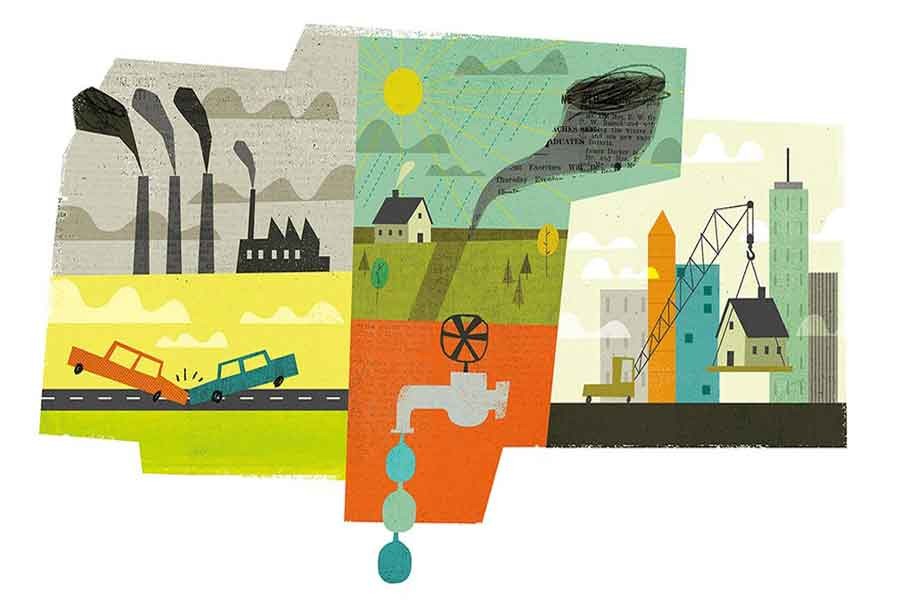Bangladesh is losing 2.7 per cent of its gross domestic product (GDP) each year due to environmental degradation mostly in urban areas, according to the preliminary findings of a recent World Bank (WB) study. Rapid and unplanned urbanisation is causing severe air and water pollution in the towns and cities.
In fact, the entire nation is losing one per cent (around Tk 200 billion) of the GDP every year due to air pollution. Indoor air pollution is causing a further 0.6 per cent GDP reduction. In addition, inadequate water, sanitation and hygiene facility is costing the country 0.4 per cent of its GDP. Another 0.5 per cent GDP loss is due to workplace environment risks. The country's GDP stands at nearly Tk 20.88 trillion as per the latest data of Bangladesh Bureau of Statistics (BBS).
The WB analysis has also found that 5.3 million people in the country would be vulnerable to the effects of climate change by 2050, while this would also lead to reduction in agricultural productivity, increase in malnutrition and decrease of water availability.
The pollution in Dhaka alone in so severe that around 0.6 million residents are exposed to lead contamination, which can lead to IQ loss and neurological damage, especially among children. Again, for just one metric tonne of fabric, the dyeing and finishing factories discharge 200 tonnes of wastewater to rivers, leading to health hazards in the capital's poorer neighbourhood.
The towns and cities in Bangladesh are also highly vulnerable to water-logging and floods due to wetland encroachments and lack of waste management systems. For instance, Pabna lost nearly half of its wetland since 1990. Now, it is facing prolonged water-logging.
As for Dhaka, the portion of permanent wetland in the capital has decreased from 14 per cent back in 1996 to 4.0 per cent in 2009. Every year, the government allocates enough money for digging ponds or canals across the country. But when that money flows to the grass-roots level, it is found that almost 50 per cent of the canals have not been dug or 17 per cent of the ponds have not been excavated.
The brick kilns are the biggest air polluter. They contribute 38 per cent micro-pollutants while motor vehicles are responsible for 19 per cent, road dust 18, solid dust nine and metal smelters seven per cent. Another major problem is lead. Nearly 600,000 people living in 59 hotspots in Dhaka and its adjacent areas are exposed to lead contamination. Lead can cause neurological damage, especially among children, at any detectable level. The children's blood lead levels are at 14-15ug/dl in Dhaka's industrial areas.
It is found that just to produce one tonne of fabrics, the dyeing and finishing factories discharge 200 tonnes of wastewater into rivers leading to health hazards in the capital's poorer neighbourhoods. There are a total of 719 such washing, dyeing and finishing factories in and around Dhaka.
In fact, development in the country often comes at the cost of environment, which ultimately affects the long-term sustainability of growth and progress. The common perception here is that politicians are corrupt, but the politicians cannot do anything without the cooperation of the administration.
However, experience around the world shows that it is possible to develop greener and cleaner without growing slower. A National Environmental Protection Agency or Authority can be created in Bangladesh with a mandate for pollution management, including countrywide industrial wastewater management. A separate 'environment cadre' may also be created in the civil service to attract and retain talented and competent individuals in the environment sector.
There is a need for establishing a training centre to build awareness and capacity on environment management across all levels. A functional review of the Department of Environment (DoE) and increasing its staff members according to international norms are required for strengthening the capacity of its divisions and district offices based on priority basis.
Meantime, the government should incorporate wetlands into urban planning and invest in waste management to improve the cities' resilience. It should provide incentives to industries to adopt green and clean technologies and enforce polluter pay principle -- a practice wherein those who are responsible for pollution should bear the costs of managing it.
There is also a need for further scaling up Resource Efficient and Cleaner Production (RECP) initiatives, as those may lead to efficiency gain, lower resource use and reduced pollution discharge. The study also suggested enforcing environment policies and strengthening institutions.
As Bangladesh is rapidly urbanising, what is required at the moment is that the country should manage the urbanisation and industrialisation process in an environmentally sustainable way.


